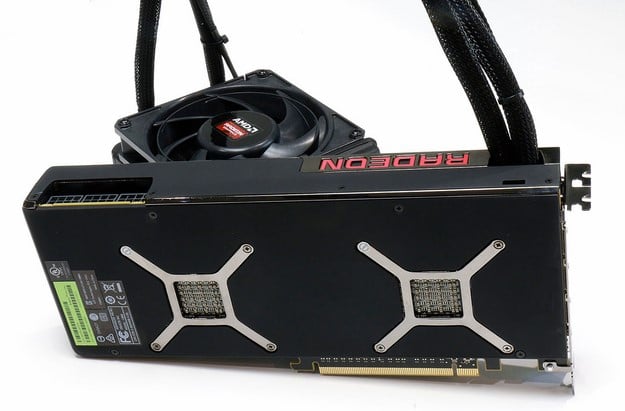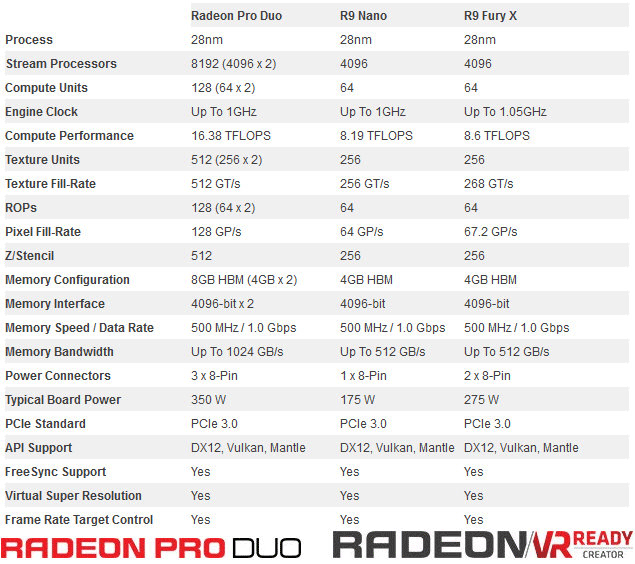AMD Radeon Pro Duo Benchmarked And Tested
Radeon Pro Duo Recap, Test Setup, Pro Graphics Quick Take
The following coverage here on the pages ahead is of AMD's Radeon Pro Duo, a high performance desktop and workstation class graphics card...

As you might imagine, we were more than a little surprised when AMD informed us they wouldn't be sampling the card to members of the Tech press. The company had its reasons, which we won't speculate on, but will offer again the statement that AMD made, which is that the Radeon Pro Duo is a graphics card for “gamers who create, and creators who game." Quite frankly that sounded a LOT like many of us here at HotHardware. After all, we render, transcode, build and create lots of content for various platforms both web, video and otherwise. We are indeed that exact demographic of creators who game. The Radeon Pro Duo would surely be in good hands with us, so we thought, but that was not in AMD's plan. And so we set out to obtain a card through the other channels we have at our disposal here, because we thought it was important for you the reader to see what it was made of performance-wise, and what AMD had been so proud of showing off for the last 11 months or so.
|
We should note, however, that because we only had a card on hand for a couple of days, that we were unable to perform our usual power consumption load testing, though at 375W TDP, you can bet it's a beast in that regard and your PSU needs to be up to its tri-8-pin PCIe power connector required task.
How We Configured Our Test Systems:
We tested the graphics cards in this article on an ASUS X99 chipset based motherboard powered by an Intel Core i7-5960X octal-core processor and 16GB of Corsair DDR4 RAM. The first thing we did when configuring the test system was enter the system UEFI and set all values to their "high performance" default settings and disable any integrated peripherals that wouldn't be put to use. The memory's X.M.P. profile was enabled to ensure optimal memory performance and the solid state drive was then formatted and Windows 10 Professional x64 was installed and fully updated. When the installation was complete, we installed all of the drivers, games, and benchmark tools necessary to complete our tests.

AMD Crimson Driver For Radeon Pro Duo
|
|
|
| Hardware Used: Intel Core i7-5960X (3GHz, Octa-Core) ASUS X99 Motherboard (Intel X99 Chipset) Radeon Pro Duo 8GB Radeon R9 Nano 4GB 3 x NVIDIA GeForce GTX 980 Ti 6GB NVIDIA Quadro M6000 12GB 16GB Corsair DDR4-2133 Intel SSD 750 Integrated Audio Integrated Network |
Relevant Software: Windows 10 Pro x64 (10586) AMD Radeon Crimson v16.4.2 AMD FirePro Workstation Driver v15.301.2401 NVIDIA GeForce Drivers v364.72 NVIDIA Quadro ODE Drivers v363.13 Benchmarks Used: 3DMark "Fire Strike" Thief MIddle-Earth: Shadow Of Mordor Metro Last Light Far Cry Primal Hit Man Absolution Luxmark SPECViewperf 12 |

|


We should note that, in this test and the following SPECviewperf testing, we exclusively used AMD FirePro and NVIDIA Quadro pro workstation drivers for testing, since these are pro workstation and content creation type applications and benchmarks. Regardless, here you can see that the Radeon Pro Duo offers excellent performance, almost two times that of a single GeForce GTX 980 Ti card or a single NVIDIA Quadro M6000. Of note here is that the Quadro card's 12GB GDDR5 frame buffer offers no advantage but rather GPU compute throughput is being measured more so than anything else.
SPECviewPerf 12 is the latest version of the venerable SPEC benchmark. The entire test suite has been overhauled for this version, including a new extensible architecture that's designed to make SVP easier to customize and adapt for a variety of workloads. The test now includes new medical and energy datasets, updates classic viewsets, and includes a new test for the Autodesk Showcase application. SPEC.org notes: "SPECviewperf 12 measures the 3D graphics performance of systems running under the OpenGL and Direct X application programming interfaces. The benchmark’s workloads, called viewsets, represent graphics content and behavior from actual applications."
SpecViewPerf includes a variety of tests, so we've chopped them up to make the results easier to read. These tests are true workstation CAD, rendering and modeling tests.


So, on one hand the Radeon Pro Duo offers serious rendering horsepower for content creation workloads, but it's not a "big iron" type workstation card either. Rather, the Pro Duo is something in between, at least for now. But never mind this "workstation" stuff, we know you want look at the Pro Duo's gaming chops.







